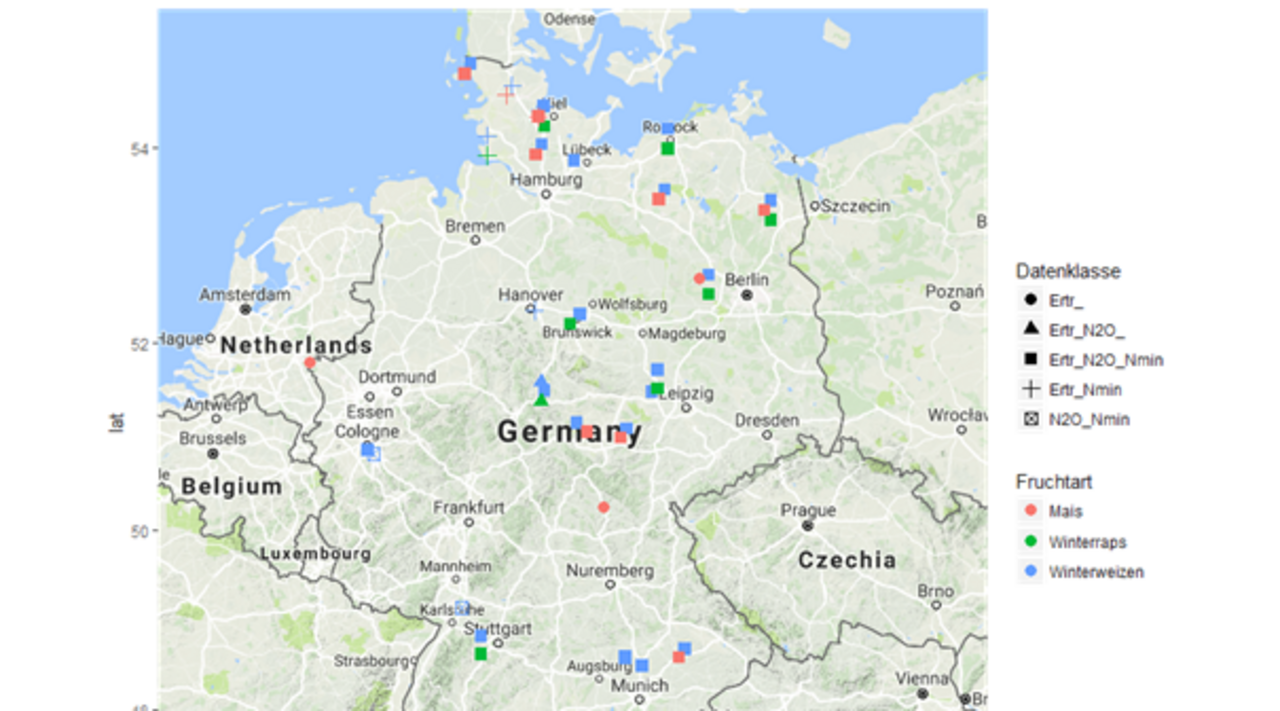Project
Effects of data requirements and uncertainty on prediction accuracy for model based evaluation and mitigation of nitrous oxide emissions from raw material cropping systems (THG-EMOBA).

Effects of data requirements and uncertainty on prediction accuracy for model based evaluation and mitigation of nitrous oxide emissions from raw material cropping systems (THG-EMOBA).
Biogeochemical models are promising tools to assess management options to mitigate nitrous oxide emissions from raw material production in agriculture. We analyse the effects of model complexity and data quality on the accuracy of model results.
Background and Objective
Agricultural biomass for bioenergy production can substitute fossil fuels which mitigates greenhouse gas emissions because the carbon within the biomass is withdrawn from the atmospheric carbon dioxide by photosynthesis. However, bioenergy production is not climate neutral. Greenhouse gas emissions come from energy use and operating resources, from the cultivated area and transformation of biomass to utilizable energy sources. Out of these diverse greenhouse gas sources, direct and indirect nitrous oxide emissions from cultivation areas are difficult to estimate. Microbial driven processes cause these emissions. Natural conditions, for instance soil properties and weather, and agricultural management affect their intensity, location and timing. Models of different complexity have been developed to estimate direct and indirect nitrous oxide emissions from soils and might be useful tools to support assessing and optimizing the cultivation of bioenergy crops.
However, models are just simplified descriptions of real world processes and modelled results come with an uncertainty caused by these simplifications. Complex models usually have many parameters that need to be adjusted and require a lot of input data. Uncertain and missing information cause more uncertain model results. These uncertainties restrain the usefulness of models when predicting N2O emissions. Our project will analyse how data availability and model complexity determine the usefulness and accuracy of model predictions.
Approach
We use a comprehensive data set of field experiments spread across Germany to evaluate the prognostic accuracy of four models related to direct N2O emissions, nitrate leaching and crop yield for the bioenergy crops maize, wheat and rape. Applied models are the HUME model developed at the Christian Albrecht University of Kiel, the process based model DNDC and two empirical approaches (GNOC and MODE). Models will be calibrated to predict measured nitrous oxide emissions, crop yield and nitrate leaching.
The effect of data quality will be tested by stepwise decreasing quality of input data. To study input data quality effects on different scales, input data modification will be done based on the data set of field experiments and based on spatial data fields for the region of North Rhine Westphalia.
Data and Methods
Results
As central part of the project, a data set was compiled that summarizes the data available so far on experiments measuring nitrous oxide emissions and agricultural yields. This data set with information about soil properties, management conditions and meteorological variables will also allow the future evaluation and further development of models to describe greenhouse gas emissions, agricultural production and soil carbon development.
The results of the GHG scenarios show that the climate impact of bioenergy production is influenced by local conditions, regardless of the plant species, the energy source produced or the model used. In the modelled scenarios, GHG savings correlated with direct annual nitrous oxide emissions, which were sensitive to soil and climatic conditions. Thus, the effect of local soil and weather conditions on annual direct N2O emissions proved to be crucial for the GHG savings of bioenergy production. Locally differentiated nitrous oxide emission potentials and emission reduction potentials should be taken into account in the efficient planning and implementation of reduction measures.
Comparative sensitivity studies showed that the effect of data uncertainties in soil and climate data depends on the modelled target variable and the type of model. Uncertainties in the description of soil data had a particular impact on modelled annual nitrous oxide emissions. Here, process-based models proved to be more sensitive to data uncertainties than empirical model approaches.
Metamodels were developed based on the scenarios, which calculate nitrate leaching losses depending on management, seasonal weather conditions and soil conditions with low data requirements.
Thünen-Contact

Involved Thünen-Partners
Involved external Thünen-Partners
- Christian-Albrechts-Universität zu Kiel
(Kiel, Deutschland)
Funding Body
-
Fachagentur Nachwachsende Rohstoffe e.V. (FNR)
(national, öffentlich)
Duration
1.2019 - 9.2022
More Information
Project funding number: 22402518
Funding program: FNR
Project status:
finished

![[Translate to English:] [Translate to English:]](/media/_processed_/6/4/csm_titel_CO2Kampagne8_afeea2273e.png)
![[Translate to English:] [Translate to English:]](/media/_processed_/4/1/csm_titel_93px_CO2Kampagne8_9b0f3354d4.png)





